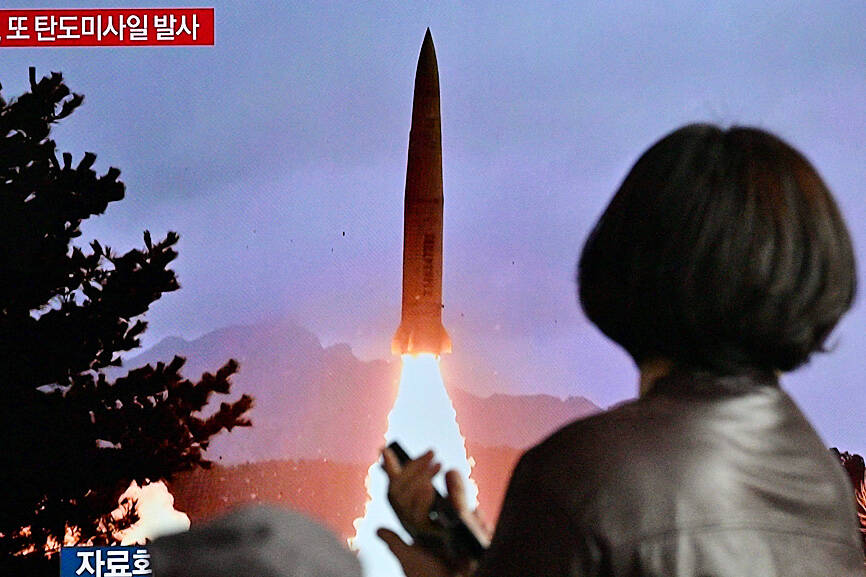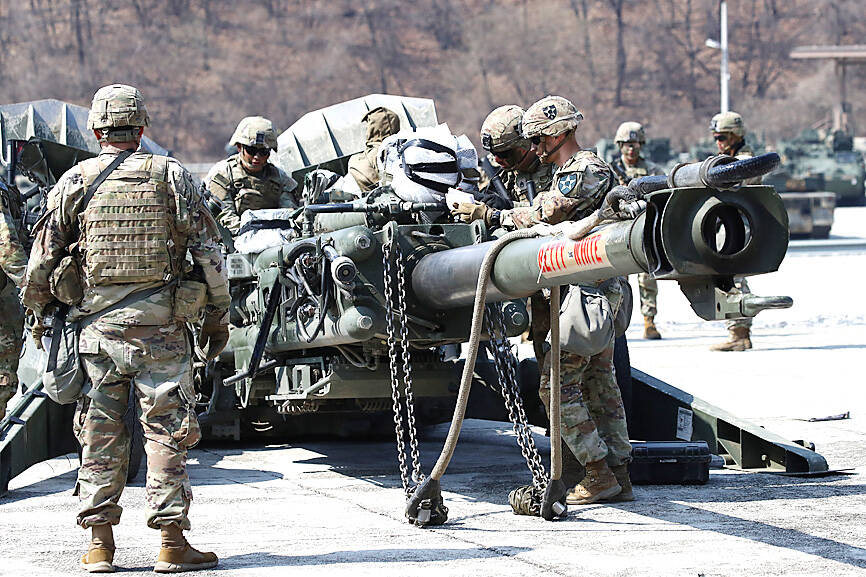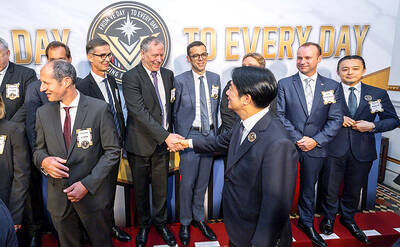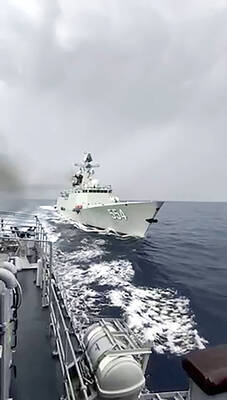North Korea yesterday fired a short-range ballistic missile, Seoul’s military said, its fourth show of force in a week as South Korea and the US stage major military drills.
Seoul and Washington have ramped up defense cooperation in the face of growing military and nuclear threats from the North, which has conducted a series of increasingly provocative banned weapons tests in the past few months. South Korea and the US are in the middle of 11 days of joint drills known as Freedom Shield, their largest in five years.
North Korea views all such exercises as rehearsals for an invasion, and has repeatedly said it would take “overwhelming” action in response.

Photo: AFP
“Our military detected one short-range ballistic missile fired from around the Tongchang-ri area in North Pyongan province at 11:05am towards the East Sea,” the South Korean Joint Chiefs of Staff (JCS) said, referring to the body of water also known as the Sea of Japan.
The missile appeared to have fallen outside Japan’s exclusive economic zone, Kyodo News reported, citing unnamed government sources.
The missile flew 800km and was under analysis by US and South Korean intelligence, the JCS said in a statement, calling the launch “a serious provocation” that contravened UN sanctions.

Photo: EPA-EFE
“Our military will maintain a solid readiness posture based on its ability to overwhelmingly respond to any provocation by North Korea, while carrying out intensive and thorough combined exercises and drills,” it said.
Tokyo also confirmed the launch, with Japanese Vice Minister of Defense Toshiro Ino telling reporters that Japan had “lodged a vehement protest to and strongly condemned [North Korea] through our embassy in Beijing.”
In Taipei, the Ministry of Foreign Affairs in a statement yesterday condemned the North for undermining regional peace and stability.
Since last year, North Korea’s frequent missile launches and preparations for nuclear tests have heightened tensions in the Korean Peninsula and the Indo-Pacific region, the ministry said.
As democratic partners in the Indo-Pacific region, Taiwan and South Korea face military threats from communist dictatorships, it said.
Taiwan would continue to monitor the North’s provocations and cooperate with like-minded countries to promote peace, prosperity and denuclearization of the Korean Peninsula, as well as to curb authoritarianism, it added.
The South Korean Ministry of National Defense said hours after the launch that it had staged joint air drills with the US featuring at least one US B-1B long-range bomber.
The missile launch came a day after North Korean state media reported that more than 800,000 young North Koreans had volunteered to join the army to fight “US imperialists.”
On Thursday, Pyongyang test-fired its largest and most powerful intercontinental ballistic missile, the Hwasong-17.
The UN Security Council is today expected to hold an emergency meeting about the launch at the request of the US and Japan, Yonhap news agency reported.
Additional reporting by Liu Tzu-hsuan

DEFENDING DEMOCRACY: Taiwan shares the same values as those that fought in WWII, and nations must unite to halt the expansion of a new authoritarian bloc, Lai said The government yesterday held a commemoration ceremony for Victory in Europe (V-E) Day, joining the rest of the world for the first time to mark the anniversary of the end of World War II in Europe. Taiwan honoring V-E Day signifies “our growing connections with the international community,” President William Lai (賴清德) said at a reception in Taipei on the 80th anniversary of V-E Day. One of the major lessons of World War II is that “authoritarianism and aggression lead only to slaughter, tragedy and greater inequality,” Lai said. Even more importantly, the war also taught people that “those who cherish peace cannot

STEADFAST FRIEND: The bills encourage increased Taiwan-US engagement and address China’s distortion of UN Resolution 2758 to isolate Taiwan internationally The Presidential Office yesterday thanked the US House of Representatives for unanimously passing two Taiwan-related bills highlighting its solid support for Taiwan’s democracy and global participation, and for deepening bilateral relations. One of the bills, the Taiwan Assurance Implementation Act, requires the US Department of State to periodically review its guidelines for engagement with Taiwan, and report to the US Congress on the guidelines and plans to lift self-imposed limitations on US-Taiwan engagement. The other bill is the Taiwan International Solidarity Act, which clarifies that UN Resolution 2758 does not address the issue of the representation of Taiwan or its people in

Taiwanese Olympic badminton men’s doubles gold medalist Wang Chi-lin (王齊麟) and his new partner, Chiu Hsiang-chieh (邱相榤), clinched the men’s doubles title at the Yonex Taipei Open yesterday, becoming the second Taiwanese team to win a title in the tournament. Ranked 19th in the world, the Taiwanese duo defeated Kang Min-hyuk and Ki Dong-ju of South Korea 21-18, 21-15 in a pulsating 43-minute final to clinch their first doubles title after teaming up last year. Wang, the men’s doubles gold medalist at the 2020 and 2024 Olympics, partnered with Chiu in August last year after the retirement of his teammate Lee Yang

The Philippines yesterday criticized a “high-risk” maneuver by a Chinese vessel near the disputed Scarborough Shoal (Huangyan Island, 黃岩島) in a rare incident involving warships from the two navies. The Scarborough Shoal — a triangular chain of reefs and rocks in the contested South China Sea — has been a flash point between the countries since China seized it from the Philippines in 2012. Taiwan also claims the shoal. Monday’s encounter took place approximately 11.8 nautical miles (22km) southeast” of the Scarborough Shoal, the Philippine military said, during ongoing US-Philippine military exercises that Beijing has criticized as destabilizing. “The Chinese frigate BN 554 was